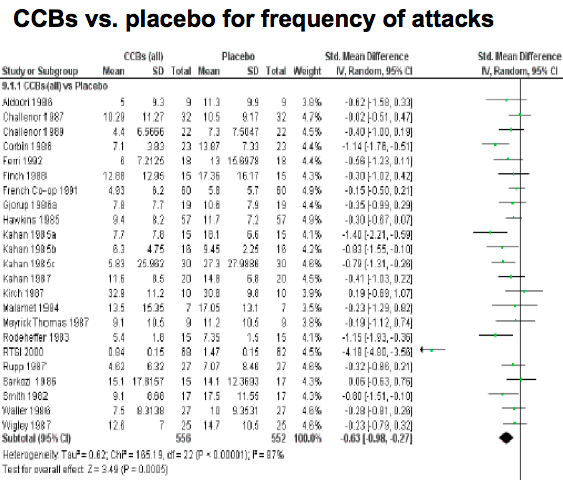Session Information
Date: Monday, November 9, 2015
Title: Systemic Sclerosis, Fibrosing Syndromes and Raynaud's - Clinical Aspects and Therapeutics Poster II
Session Type: ACR Poster Session B
Session Time: 9:00AM-11:00AM
Background/Purpose: To assess the benefits and harms of calcium
channel blockers (CCBs) versus placebo for the treatment of Raynaud’s
phenomenon (RP) comparing primary to secondary RP associated with connective
tissue disease (CTD), especially systemic sclerosis (SSc).
Methods: The Cochrane library, MEDLINE, EMBASE and
Clinicaltrials.gov were searched up to June 2014 for randomized controlled
trials (RCTs) examining RP. Outcomes of interest were: Frequency, Duration and Severity
of RP attacks, Pain, Patient global, Withdrawals and Serious adverse events.
Fixed effects models were used to calculate mean differences (MD) or
standardized mean differences (SMD) for continuous outcomes and risk ratios for
dichotomous outcomes. Heterogeneity was determined and significant if I2>50%. Subgroup
analyses by: disease type (primary
or secondary), CCB dosage (low, medium or high) and CCB drug were performed.
Results: Of the 2337 articles, 939 participants from 36 RCTs
investigating the effect of CCBs vs. placebo were included. The majority were
crossover RCTs with low to moderate quality using low dose CCBs. CCBs were more
effective in reducing the frequency of attacks (22 RCTs, N=978, MD -2.62, 95%CI
-3.38,-1.88, p<0.00001, Figure) and the severity of attacks (17 trials, N=792,
MD -0.73 95%CI -0.99, -0.47, p<0.00001).No significant differences in
duration, pain or withdrawals between CCBs and placebo occurred. Patient global
was only reported in one study. CCBs reduced the frequency and severity of
attacks irrespective of dosage, particularly for primary RP. CCBs reduced
frequency of attacks/week in primary RP by 3.9 vs. 0.5 in secondary RP. Similar
results were seen in severity of attacks for low dose vs. medium dose CCBs and
primary vs. secondary RP. Low dose CCBs reduced the frequency of attacks by 3.3
per week vs. medium dose at 5.6. Crossover studies may have had carryover
effects.
Conclusion:
Primary RP is more responsive to CCBs than secondary from CTD especially SSc.
To cite this abstract in AMA style:
Pope JE, Rirash F, Tingey P, Harding S, Maxwell LJ, Tugwell P, Pardo J, Ghogomu E, Wells GA. Calcium Channel Blockers Are More Effective in the Treatment of Primary Raynaud’s Phenomenon Compared to Secondary: A Meta-Analyis [abstract]. Arthritis Rheumatol. 2015; 67 (suppl 10). https://acrabstracts.org/abstract/calcium-channel-blockers-are-more-effective-in-the-treatment-of-primary-raynauds-phenomenon-compared-to-secondary-a-meta-analyis/. Accessed .« Back to 2015 ACR/ARHP Annual Meeting
ACR Meeting Abstracts - https://acrabstracts.org/abstract/calcium-channel-blockers-are-more-effective-in-the-treatment-of-primary-raynauds-phenomenon-compared-to-secondary-a-meta-analyis/

